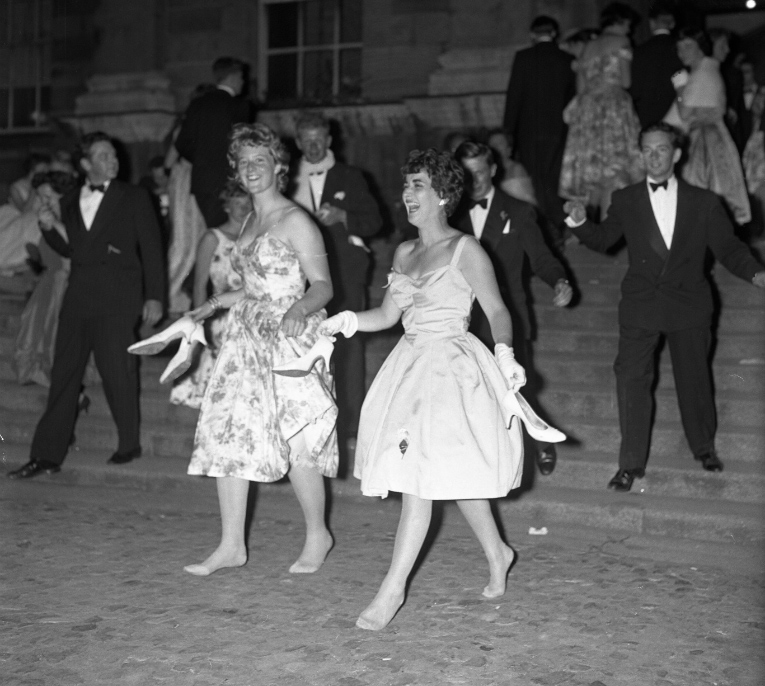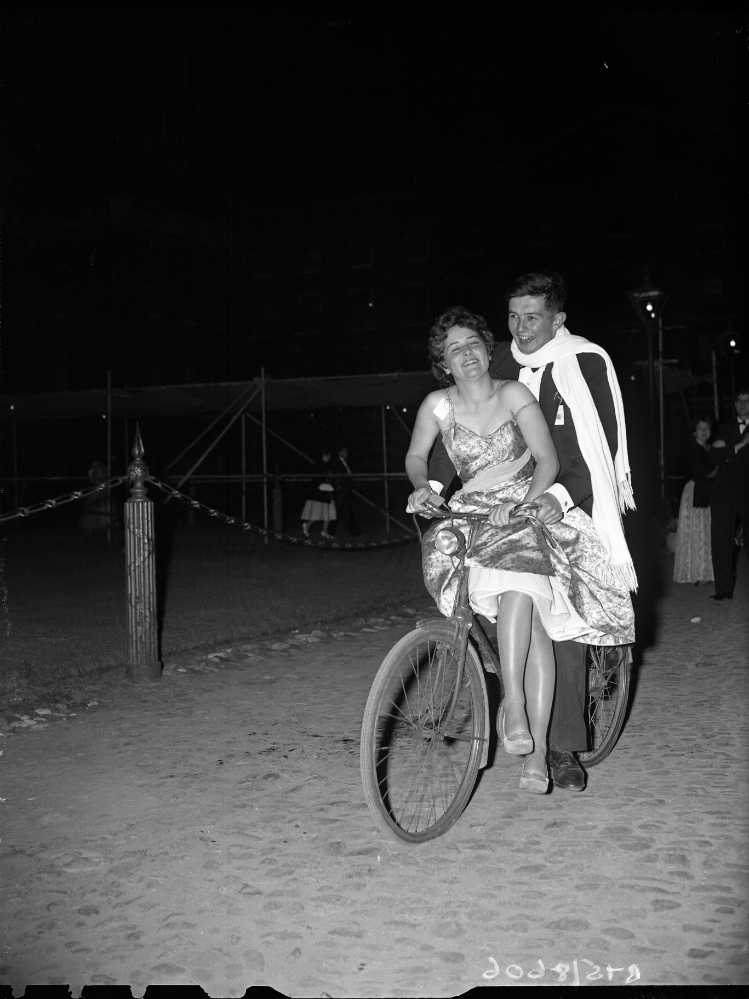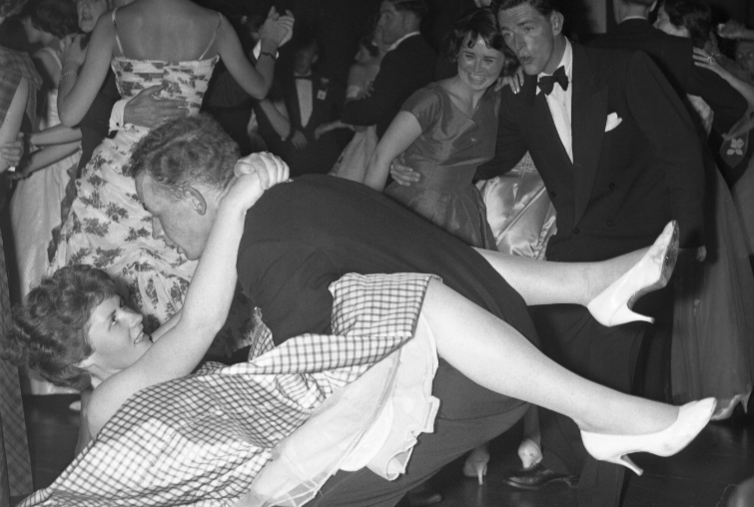Charlotte Ryan | Junior Editor
efore I was made aware of the term “problematic” and how it applied to Walt Disney and a fair share of his movies, I was a devout disciple of Disney. As a blue-eyed blonde who looked eerily like a small animated doll, a special place was reserved in my heart for Cinderella. That ball gown, that voice, that satisfying and irredeemably melodramatic outlook it inspired that the world owes you for the pains of cushy childhood you had to suffer through, and would provide compensation. Namely, some pretty clothes, an equally pretty prince and a Ball at which to show them off.
These notions of glamour were tempered by the tales my former-socialite grandmother would tell me, stories of galas and nights that sparkled with champagne and lacquered pin-curls. Knowing of my aspirations to study at Trinity, she would often bookend her tales with mention of Trinity Ball, citing it as the shiniest gem in the tiara of Dublin society. Indeed it was the social highlight of the year, and certainly one of the most exclusive events in the city. This is still the case, at least in the eyes of Trinity Ents who proudly proclaim it to be “Europe’s largest private party”. Its exclusivity is no surprise when it is considered that the origins of Trinity Ball lie in its ancestor, the May Ball of Cambridge University.
These notions of glamour were tempered by the tales my former-socialite grandmother would tell me, stories of galas and nights that sparkled with champagne and lacquered pin-curls.
Having started in the 1830s, the May Ball is a revered institution that most likely spawned from the celebrations of May Bumps, a series of rowing races that took place prior to the college examination period. The tradition became official after the First and Third Trinity Boat Club May Ball was held by Trinity College, Cambridge in 1866 to celebrate successes in rowing, and its fellow colleges picked up the practice. Attendance was granted only to residents of the colleges, further enhancing the air of elite exclusivity.
The dress code was preferably white tie, although black tie was accepted, and the evening usually comprised of a luxurious meal of the highest quality and ever-flowing rivers of champagne. A cursory glance at the 1929 menu for the St. Catherine’s May Ball, which included such appetising culinary delights as chicken aspic and jellied turkey, asserts its Cambridge roots by being markedly written en français. In recent decades, the May Ball has shifted with trends and demands to include such delights as carnival rides and humbler treats like doughnuts and burgers (albeit ostrich burgers), but not before the tradition was transplanted to our own Trinity College Dublin.
Photographs hint at a marvellously glamourous soirée with a healthy dose of debauchery sweetening the mixture.
For College to have adopted this long-established tradition as its own is hardly surprising, given that the university was originally modelled on both Oxford and Cambridge. However, from its first ball in 1959 it was evident that Trinity would give the event a spin that was distinctly its own. From the photographs taken at that inaugural ball one immediately discerns a more relaxed tone: favouring black tie over white, the pictures show coiffed glamour pusses in full skirts and with high heels in hand; impossibly tanned dreamboats kissing their sweethearts; charmingly dishevelled couples sipping tea on the grass. They hint at a marvellously glamourous soirée with a healthy dose of debauchery sweetening the mixture.
Trinity Ball of decades past was nonetheless a much quieter affair than it is known to be now. Most of the entertainment took place in the classy confines of College Buildings. A Trinity News article in 1961 explained there would be ‘a night club in the G.M.B’. and ‘dancing in the dining hall and the marquee’. Apparently, there was also a bar set up beneath the Campanile but a 1965 TN article announced this was changing to satiate the larger demand and that in its place there would be ‘two long bars running east and west from the Campanile’.
David Norris recalls how he ‘danced in the dining hall to the strains of Strauss waltzes and did the Charleston in the Exam Hall to the music of Chris Barber’s jazz band.’
The highlights of the ball that year included “an open-air ballad session between the Library and the Rubrics” during which three groups serenaded the masses and a “highly professional cabaret” – sounding not at all suspicious – entranced the revellers in the G.M.B. The Ball that year also featured a “Star attraction” in the guise of Trinity Graduate Terence Brady, a man “well known for his classic interpretation of the Junior Dean, for which he once fined a student £5.” When Senator and Trinity alumnus David Norris attended the following year he recalls how he ‘danced in the dining hall to the strains of Strauss waltzes and did the Charleston in the Exam Hall to the music of Chris Barber’s jazz band.’

In terms of refreshments, far from the realm of possibility were scaldy chips and kebabs devoured hastily behind the Portaloos. In their stead, as Norris recalls, were suckling pigs roasting on a spit in the since removed Fellows Gardens, the latter a delightfully carnal display at odds with its elegant location. At the same time that Trinity College Dublin were offering these light and lively entertainments, students in Cambridge were growing dissatisfied with the prim and dreary events of their annual May Ball. Thus, the Balls of the seventies and the eighties were driven by a new focus on rock and pop acts which was dutifully mimicked on the greener side of the Irish Sea.
Bacik remembers the headliners, iconic pop band The Smiths, whose set was by all accounts “legendary”.
By the time that Senator and senior lecturer, Ivana Bacik, came to walk Parliament Square as an undergraduate, Trinity Ball had gained enough credibility as an event to secure some incredibly high profile music acts. Having attended the Ball in the years 1987-1990 as an undergrad, Bacik ruefully admits that “It’s a matter of lasting regret that I didn’t go to the Ball in my first year in 1986, so I never saw Public Enemy, who played that year”. That gig in particular is one of the Ball’s most infamous, with the US rappers utilising their moment on the stage to moralise on the Northern Irish issue, the irony being sealed by hundreds of largely middle-class students moshing in drunken agreement. Bacik also mentions the headliners of the year before she entered the college, iconic pop band The Smiths, whose set was by all accounts “legendary”.
It was during this time that the Ball began to take the shape of what we now recognise as Trinity Ball: the open air stages, the barriers, the distinctly more festival vibe that permeates the night. Whereas in the time of David Norris each act was held in a college building, Bacik remembers there being multiple stages dotted around campus with the odd DJ or live band rigged up in the Buttery or Exam Hall. Provost, Patrick Prendergast, also recalls college buildings such as the Arts Block and the GMB being used to stage the acts, citing this as the biggest difference. While it’s not particularly fun to imagine drunkenly grinding in the same place as you eat your Maguire’s chicken fillet roll after a 9am epistemology tutorial, there is a definite romance to the idea of swaying euphorically to “There Is a Light That Never Goes Out” in Regent House, high above the bustling pathways of College Green.

As long as there has been the allure of Trinity College Campus lit up in the balmy night air of early summer, there have been people desperate enough to be involved, and foolish enough to attempt to crash the Ball. In 1965 a front page story in the Trinity News reported that ‘strict security precautions were to be taken at the ball’ that year as the previous year it had been found that ‘at least 300 extra people attended the ball either by illegal entry from College Rooms or on forged tickets’. To combat this, they warned that ‘more porters will be placed outside rooms and plain clothes detectives will mix freely with guests’. Despite these efforts, in 1968 the TN front page was emblazoned with the warning that ‘this year Trinity Ball aims to stop the invasion of customary crashers.’ To tackle this, entrants were to be ‘obliged to wear a badge for the duration of the evening’ and with the help of ‘outside security specialists assisting the porters, possibly even hired Gardai, the badgeless will be evicted’.
Even Mary Robinson couldn’t resist the thrill of sneaking in, climbing over a wall with the help of a tall ladder and her two brothers while wearing in a full-length dress.
Yet, unsurprisingly, the plethora of tame, reckless and often incredibly brazen attempts to enter the Ball have persisted down the years and become as much a part of its history as the multiple forms it has taken in the recent decades. Bacik mentions friends of hers who hid under tables in Rooms, scaled trees and attempted to sneak in through secret entrances on Pearse Street or Westland Row, plans that were “always foiled”. Even in recent years there are always stories of students hiding in attics and bins. Last year one student hid inside a suitcase in a friend’s apartment in Botany Bay and emerged a successful Trinity Ball gate-crasher.
However, there are always the less fortunate, such as the popular story of the crafty lad who climbed a leafy tree in Front Square in the early hours of the morning thinking no one could see him hiding up there. Of course security spotted this modern-day Tarzan immediately but decided to let him wait it out. By the time they came to remove him just before the Ball began, he had to be taken away in an ambulance due to hypothermia. Ents Officer, Finn Murphy, recalls another such episode that succinctly sums up the desperation felt by some to experience the Ball: “I have a friend who tried to climb over the fence along Nassau Street not realising that there’s a 30 foot drop on the other side,” Murphy says. “She had to hang on the top of the fence until the fire brigade came to lift her off. They still didn’t let her in after that!”
Even Mary Robinson (the former President of Ireland, Commissioner of the United Nations High Commission for Human Rights, and current Chancellor of this university) couldn’t resist the thrill of sneaking in in her college days. Living on Westland Row in what is famously Oscar Wilde’s birthplace she climbed over the wall behind the house with the help of her brothers, Henry and Aubrey, and a very tall ladder. ‘Henry held the ladder as I went up’ she recalls in her autobiography and Aubrey sat on the wall, coaxing me, grinning, and helping me land safely on the other side.’ She recalls proudly how she did all of this ‘in a full length-dress.’
However, the most impressive gate-crashing tale this writer has heard comes from Senator Norris, who recalls an eventful night spent sodden with cheap wine. “I tottered through a side door into college to be met by bouncers who asked me where I thought I was going and who I thought I was?” he recounts. “I told them I was the Mongolian Ambassador and was a guest at the Trinity Ball and rather to my surprise I was admitted”. The story is a testament to the different disguises guests have adopted in their attempts to get in, fit in and have their moment as belle or beau of the Ball.
I didn’t go to the Ball last year; a combination of insufficient funds and a lack of interest in that year’s line-up kept me having quiet drinks with a small group of close friends. Content with the longevity of that excuse, I was willing to trot it out again this year until getting the opportunity to research for this article. In speaking to those interviewed herein, one shared memory was consistently repeated: that of walking under Front Arch as a Trinity student at their first ever Trinity Ball and seeing all manner of people, and the campus itself, dressed up and shimmering in the scintillating lights. It reminded me of the marvellous position I am in to experience such an iconic and historical event. Countless are the young girls like me, and more than a few boys, inspired by the allure of that night to defy their supposed maturity and third level grade cynicism and to sit dreaming of fairy godmothers and glass slippers.
And if our feet blister? Sure, few naggins. Be grand.
Rachel Lavin contributed research to this piece.
Special thanks to the Irish Photo Archive for providing the above photos of the 1959 Trinity Ball. View more photos here.







